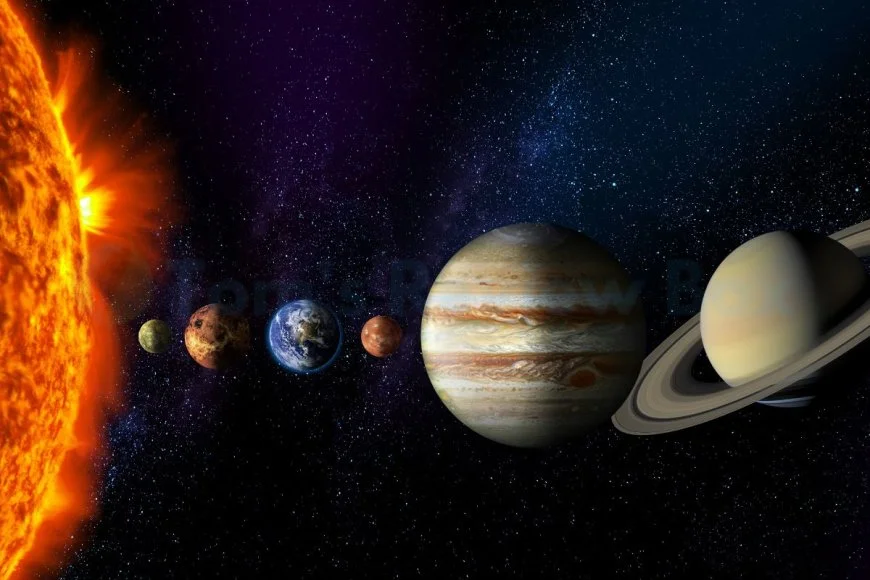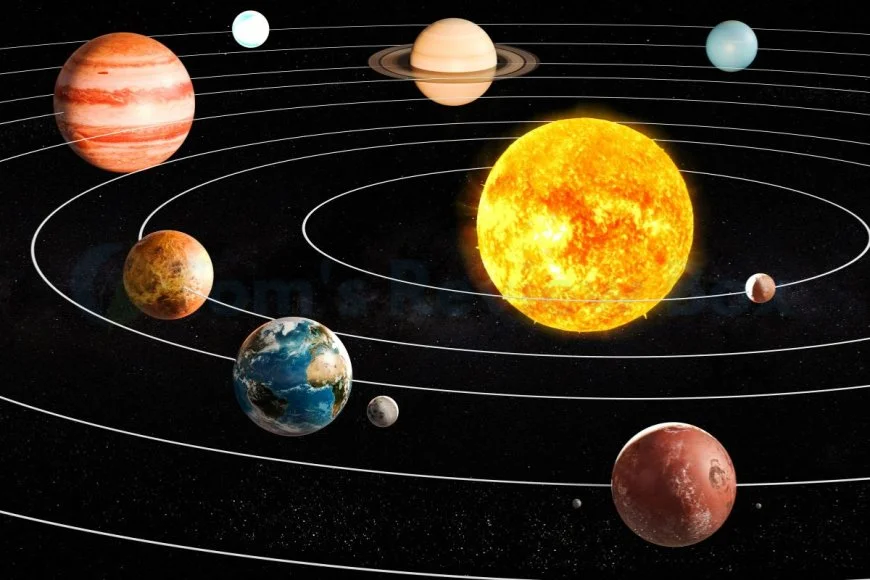Which Planet Is the Hottest in Our Solar System: Venus Unveiled
Discover the hottest planet in our solar system. Learn about Venus, its extreme temperatures, and why it takes the crown.

Ever wondered which planet sizzles as the hottest in our solar neighborhood? The answer might surprise you. Among all the planets orbiting the sun, one stands out with scorching temperatures that could melt lead. Curious to uncover this celestial hot spot and what makes it so fiery wonders?
Key Takeaways
-
Venus Holds the Title: Venus is the hottest planet in our solar system due to its thick atmosphere and greenhouse effect.
-
Educational Insight: Understanding the factors that make Venus, with a mean surface temperature of 467 degrees Celsius, the hottest planet at more than 460 degrees Celsius, can deepen our knowledge of planetary climates and atmospheres.
-
Greenhouse Effect Awareness: The extreme temperatures on Venus highlight the impact of greenhouse gases and their role in trapping heat.
-
Exploration Importance: Studying Venus through exploration missions helps scientists uncover more about its unique characteristics and extreme conditions.
-
Climate Relevance: Venus serves as a valuable case study for understanding climate change and the effects of atmospheric conditions on planetary temperatures.
-
Educational Engagement: Exploring Venus not only expands our scientific knowledge but also enriches cultural and educational perspectives on space exploration.
Solar System Overview
Planetary Temperatures
The temperature ranges on different planets vary significantly. For instance, Mercury can reach up to 800 degrees Fahrenheit. In contrast, Neptune can drop as low as -360 degrees Fahrenheit. These extremes showcase the diversity of temperatures in the solar system. The distances of planets from the sun play a crucial role in determining their temperatures.
Temperature Variations
The temperature variations on planets are influenced by multiple factors. One key factor is the atmosphere, which acts as a blanket, trapping heat and regulating temperatures. Planets with thicker atmospheres tend to have more stable temperatures. The tilt of a planet's axis affects how sunlight is distributed, leading to seasonal changes and temperature fluctuations.
Venus Overview
Venus, often referred to as Earth's sister planet, is known for its extreme conditions. It has a thick atmosphere composed mainly of carbon dioxide, creating a runaway greenhouse effect that makes it the hottest planet in our solar system. Despite being the second planet from the sun, Venus experiences higher temperatures than even Mercury due to this intense greenhouse effect.
Venus's surface temperature can soar up to a scorching 900 degrees Fahrenheit, hot enough to melt lead. This extreme heat is primarily due to its thick atmosphere that traps heat and prevents it from escaping back into space. Unlike other planets with more moderate temperatures, Venus showcases the impact of an intensified greenhouse effect on planetary conditions.
Key Facts about Venus:
-
Second planet from the sun.
-
Often called Earth's sister planet.
-
Has a dense atmosphere mainly consisting of carbon dioxide.
-
Experiences extreme temperatures due to a strong greenhouse effect.
Planet Temperature Comparison
Mercury vs Venus
Mercury and Venus, two inner planets, exhibit extreme temperature differences. Mercury experiences scorching daytime temperatures up to 800°F, while nighttime temperatures plummet to -290°F. In contrast, Venus, with an average surface temperature of 900°F, surpasses Mercury's heat despite being farther from the Sun. The thick atmosphere of Venus traps heat, creating a runaway greenhouse effect that contributes to its intense heat.
Earth vs Mars
Earth and Mars showcase significant temperature variations due to their varying atmospheres. Earth maintains a moderate average temperature of 59°F, ideal for supporting diverse life forms. Factors like the presence of water, protective magnetic field, and breathable atmosphere contribute to Earth's habitable conditions. On the other hand, Mars experiences extreme cold with average temperatures around -80°F. The thin atmosphere on Mars fails to retain heat effectively, leading to freezing conditions.
Outer Planets
Journeying beyond the inner planets unveils the frigid temperatures of the outer solar system. Saturn, Uranus, and Neptune are known for their icy climates due to their distance from the Sun. Saturn's average temperature is a bone-chilling -288°F, making it one of the coldest planets in our solar system. Uranus and Neptune also experience subzero temperatures due to their distance from the Sun and unique atmospheric compositions. These outer planets possess distinct features such as icy rings and turbulent storms influenced by their cold environments.

Venus Deep Dive
Extreme Conditions
Space is known for its extreme temperatures, with some areas reaching hundreds of degrees. These conditions are a result of the intense radiation from stars. Planets like Venus experience extreme heat due to their proximity to the Sun. The lack of atmosphere also plays a role in these temperature variations.
The impact of extreme temperatures on planetary environments is profound. They can lead to the formation of unique geological features, such as lava flows and volcanic activity. These conditions make survival challenging for any form of life. However, extremophiles, organisms that thrive in extreme environments, have adapted to survive in such harsh conditions.
Adaptations for survival in extreme temperatures are crucial. Organisms must develop mechanisms to regulate their internal temperature and protect themselves from harmful radiation. For instance, certain bacteria have evolved heat-resistant proteins to withstand high temperatures on planets like Venus. These adaptations showcase the resilience of life in the face of extreme conditions.
High Temperatures
Among all the planets in our solar system, Venus stands out as the hottest planet. Its surface temperature can soar up to 900 degrees Fahrenheit (475 degrees Celsius). This extreme heat is primarily due to Venus's thick atmosphere composed mainly of carbon dioxide, which traps heat and creates a runaway greenhouse effect.
The implications of such high temperatures on planetary surfaces are immense. On Venus, the scorching heat leads to a landscape dominated by vast plains of volcanic rock and numerous volcanoes. The surface is hostile, with crushing atmospheric pressure and acidic clouds adding to the inhospitable environment.
Exploration missions face significant challenges when dealing with high temperatures on planets like Venus. The equipment must be specially designed to withstand these extreme conditions without malfunctioning or breaking down. For example, spacecraft sent to study Venus require advanced cooling systems and protective shielding to prevent damage from the intense heat.
Why Venus Is Hottest
Thick Atmosphere
A thick atmosphere is crucial for a planet's temperature regulation. On Venus, the thick atmosphere plays a significant role in trapping heat. The dense atmosphere on Venus contributes to its scorching surface temperatures.
The dense atmosphere of Venus contains mainly carbon dioxide, which acts as a potent greenhouse gas. This atmospheric composition effectively traps heat from the sun, leading to extreme temperatures on the planet's surface. The thick atmosphere prevents heat from escaping back into space, resulting in Venus being the hottest planet in our solar system.
Greenhouse Effect
The greenhouse effect refers to the process where certain gases trap heat in a planet's atmosphere. On Venus, this effect is exceptionally intense due to its thick carbon dioxide-rich atmosphere. The greenhouse effect on Venus leads to surface temperatures hot enough to melt lead.
Comparing greenhouse effects across planets reveals variations in temperature regulation mechanisms. While Venus experiences an intensified greenhouse effect, other planets like Earth and Mars also have greenhouse gases but at different levels. Understanding these differences helps scientists comprehend the diverse climates within our solar system.

Venus Characteristics
Surface Features
Venus, known for its extreme temperatures, has a surface dominated by vast plains, highland regions, and thousands of volcanoes. The surface is scattered with impact craters and large shield volcanoes, such as Maat Mons and Sapas Mons. These features contribute to the planet's intense heat retention and lack of significant temperature fluctuations. The thick atmosphere traps heat close to the surface, creating a runaway greenhouse effect that maintains scorching temperatures.
The dense atmosphere on Venus consists mainly of carbon dioxide with traces of nitrogen and sulfur dioxide. These gases create a strong greenhouse effect, leading to an average surface temperature of about 467 degrees Celsius (872 degrees Fahrenheit). The thick blanket of carbon dioxide absorbs sunlight and prevents heat from escaping back into space, resulting in extreme temperatures that make Venus the hottest planet in our solar system.
Atmospheric Composition
Venus's atmosphere is primarily composed of 96.5% carbon dioxide, with nitrogen making up 3.5% and trace amounts of other gases. This composition leads to a massive greenhouse effect, trapping heat and causing the planet's surface temperature to soar beyond levels found on Mercury, even though it is closer to the Sun. The thick clouds on Venus are made up of sulfuric acid droplets that reflect sunlight back into space.
-
Pros:
-
The unique atmospheric composition provides scientists with valuable insights into extreme climate conditions.
-
-
Cons:
-
The intense heat and pressure on Venus make it challenging for spacecraft to explore its surface for extended periods.
-
Venus Exploration Missions
Past Missions
Venus, often referred to as Earth's "sister planet," has captivated scientists for decades. Numerous past missions have been launched to study this enigmatic planet. The first successful mission was NASA's Mariner 2 in 1962, providing crucial data on Venus' atmosphere and surface temperature.
These early missions revealed startling facts about Venus, such as its extreme heat and dense atmosphere. The Soviet Venera program furthered our understanding with landers that sent back images and data from the planet's surface. These missions unveiled a harsh environment with temperatures soaring above 800 degrees Fahrenheit and pressure equivalent to being almost a kilometer underwater on Earth.
Advancements in technology have enabled more sophisticated missions like NASA's Magellan spacecraft, which used radar to map Venus' surface in unprecedented detail. These missions have significantly enhanced our knowledge of Venus, shedding light on its volcanic activity, unique geological features, and mysterious weather patterns.
Future Prospects
The future of Venus exploration holds exciting possibilities with upcoming missions planned by various space agencies. NASA's VERITAS mission aims to map Venus' surface topography to understand its geology better. The European Space Agency's EnVision mission seeks to study the planet's atmosphere and surface interactions comprehensively.
These future missions aspire to unravel the mysteries surrounding Venus, including its runaway greenhouse effect and potential signs of past water presence. By leveraging cutting-edge technology and scientific instruments, these missions are poised to provide groundbreaking insights into Venus' evolution and similarities/differences with Earth.
The scientific community eagerly anticipates the discoveries that these future missions will bring forth, offering new perspectives on planetary formation processes and habitability beyond Earth. With each mission building upon the knowledge gained from previous explorations, the quest to uncover the secrets of Venus continues unabated.
Venus in Culture
Historical Views
Venus, known as the hottest planet in our solar system, has captivated human imagination for centuries. Ancient civilizations viewed Venus as a symbol of beauty and love, often associating it with their deities. In Mesopotamian mythology, Venus was linked to the goddess Ishtar, representing both love and war.
These historical perspectives on Venus influenced cultural beliefs and practices across various civilizations. The Mayans incorporated Venus into their calendars and rituals, attributing mystical significance to its movements in the sky. Similarly, ancient Greeks revered Venus as the goddess Aphrodite, embodying love and fertility.
Modern References
In modern times, scientific advancements have provided deeper insights into Venus's extreme temperatures. Recent studies have revealed that Venus experiences scorching surface temperatures exceeding 800 degrees Fahrenheit (427 degrees Celsius). This intense heat is primarily due to its thick atmosphere composed of carbon dioxide and sulfuric acid clouds.
Scientific research continues to unravel the mysteries surrounding Venus's hostile environment. NASA's missions, such as the Parker Solar Probe and the upcoming VERITAS mission, aim to study Venus's atmosphere and surface in greater detail. These endeavors contribute to our evolving understanding of Venus's climate dynamics and geological features.
Educational Perspective
Venus for Kids
Venus, the second planet from the Sun, is known as the hottest planet in our solar system. Its surface temperature can reach a scorching 900 degrees Fahrenheit, hot enough to melt lead. For kids, understanding why Venus is so hot can be fascinating. Through simple explanations, children can grasp that Venus's thick atmosphere traps heat like a greenhouse. This causes its extreme temperatures. To engage young learners, fun facts like Venus spinning backward compared to other planets can captivate their interest. Interactive elements such as online games or quizzes about Venus's temperature can make learning enjoyable and memorable.
Teaching Resources
Educators looking to teach about Venus's extreme temperatures have a range of resources at their disposal. Lesson plans tailored for different age groups can help explain complex concepts in an accessible way. Activities like creating models of Venus's atmosphere or conducting experiments to demonstrate heat retention mechanisms can bring the topic to life for students. Interactive tools such as virtual tours of Venus or simulations showing temperature variations across its surface can enhance classroom discussions. Visual aids like diagrams illustrating the greenhouse effect on Venus can aid in visual learners' comprehension.
Visual Journey
NASA's Photos
NASA has captured stunning photos of Venus, showcasing the planet's unique features and extreme conditions. The visual data provided by NASA's imagery offers valuable insights into Venus's scorching temperatures. These photos allow us to witness the wonders of Venus up close, providing a glimpse into its harsh environment. Through these images, we can wonder at the beauty and mystery of our neighboring planet.
The importance of visual data in understanding Venus's temperature cannot be overstated. By analyzing these photos, scientists can lead groundbreaking research on Venus's climate and atmosphere. NASA's photos reveal key features of Venus, such as its thick clouds of sulfuric acid and intense greenhouse effect. This visual evidence helps researchers unravel the mysteries surrounding Venus's status as the hottest planet in our solar system.
Mission Imagery
Exploring images from past Venus exploration missions offers a deeper look into the planet's extreme heat levels. Mission imagery plays a crucial role in studying Venus's temperature variations and atmospheric conditions. By examining these images, scientists can witness firsthand the challenges posed by Venus's hostile environment.
The significance of mission imagery extends beyond mere visuals; it provides essential data for understanding Venus's temperature dynamics. Images captured during these missions have significantly enhanced our knowledge of Venus and its intense heat levels. By analyzing mission imagery, researchers have gained valuable insights into the factors contributing to Venus's status as the hottest planet in our solar system.
Final Remarks
Now that you have explored the scorching realms of our solar system, particularly focusing on why Venus holds the title of being the hottest planet, you have gained a deeper insight into the extreme conditions of our neighboring world. Understanding the factors contributing to Venus's intense heat not only broadens your astronomical knowledge but also highlights the delicate balance that sustains life on Earth. The exploration of Venus goes beyond scientific curiosity; it serves as a reminder of the fragility and uniqueness of our own planet, urging us to appreciate and protect our home amidst the cosmic vastness.
As you reflect on the fascinating details uncovered about Venus, consider how this newfound knowledge can inspire you to delve further into planetary exploration or even advocate for environmental consciousness here on Earth. Embrace the wonder of the cosmos and let it fuel your curiosity and drive for discovery. Keep exploring, keep learning, and keep marveling at the wonders of our universe.
Frequently Asked Questions
What is the hottest planet in our solar system?
Venus holds the title of the hottest planet in our solar system. Despite not being the closest to the Sun, its thick atmosphere traps heat, leading to surface temperatures that can soar up to 900 degrees Fahrenheit.
Why is Venus considered the hottest planet?
Venus is the hottest planet due to its dense atmosphere composed mainly of carbon dioxide. This thick blanket creates a greenhouse effect, trapping heat and causing extreme temperatures that make it hotter than even Mercury, the closest planet to the Sun.
How does Venus compare in temperature to other planets?
Venus tops the list as the hottest planet with surface temperatures reaching about 900 degrees Fahrenheit. In comparison, Mercury, despite being closer to the Sun, has lower average temperatures due to its lack of atmosphere to retain heat.
Are there any missions exploring Venus?
Yes, several missions have been dedicated to exploring Venus. Notable examples include NASA's Magellan spacecraft and more recent proposals like NASA's VERITAS mission. These missions aim to study Venus's surface and atmosphere to gain insights into its extreme conditions.
What cultural significance does Venus hold?
Venus has been a prominent figure in various cultures worldwide. Often associated with love and beauty, Venus is named after the Roman goddess of love. Its brightness and visibility make it a popular celestial object for stargazers and astronomers alike.
What's Your Reaction?







































![MacBook Pro M5: All the features and specs you need to know [LEAKS REVEALED]](https://tomsreviewbox.com/uploads/images/202502/image_430x256_67bd6d7cd7562.jpg)



























